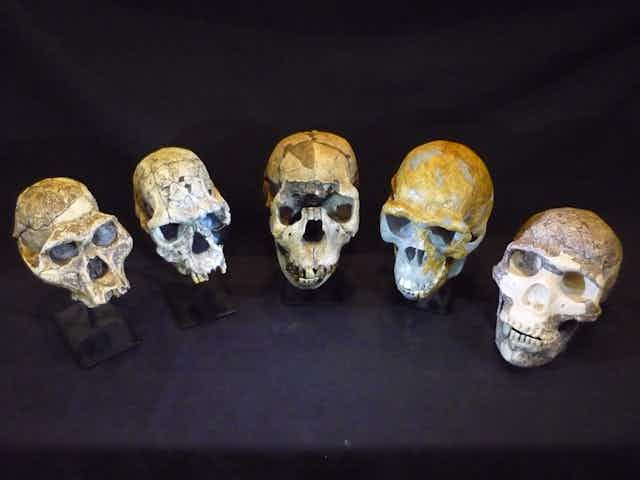Anthropologists have been curious about the evolution of human intelligence for many decades. The main lines of research have involved archaeological finds concerning the use of fire, tools and so on.
But what about looking for evidence in fossil skulls, the place where the brain resided?
The volume of the human brain increased to be about three and a half times larger than our Australopithecus ancestors 3 million years ago.
It is generally assumed that intelligence is correlated with brain size, and the reason for this is that the number of nerve cells in mammalian brains seems to be directly related to brain size.
Our research focused on the rate of blood flow to the brain, which relates closely to metabolic rate because the blood supplies the essential oxygen. If blood flow to your brain is stopped, you will pass out within seconds.
Normally you have about 7 millilitres of blood flowing to your brain each second. Remarkably, this rate changes little, regardless of whether you are awake, asleep or solving mathematical problems.
The brain’s plumbing
The blood flow to the cognitive part of the brain, the cerebrum, comes through two internal carotid arteries, one on the right and one on the left. The size of these arteries is related to the rate of blood flow through them.
Just as a plumber would install larger water pipes to accommodate a higher flow rate to a larger building, the blood circulatory system continually adjusts the sizes of blood vessels to match the rate of blood flow inside them. This in turn is related to the oxygen demand of the organ.
If we can measure the size of the large arteries that supply an organ such as the brain, we can calculate the average rate of blood flow with some accuracy.
This principle has been known for a century and its beauty lies in its simplicity.
Size matters
My eureka moment occurred when I realised that the size of an artery can be gauged by the size of the hole in a bone that it passes through.
This meant that the rate of blood flow to the brain could be measured by the sizes of the carotid canals in fossil skulls from human evolution.

It was a nice idea, but it took the enthusiasm of my student Vanya Bosiocic to turn it into a piece of research. She travelled to museums in Australia and in South Africa, gaining access to priceless fossil hominin skulls to make the measurements.
We found that the size of the carotid canals increased much faster than expected from brain size in 12 species of our human ancestors over a period of 3 million years.
While brain size was increasing 3.5 times, blood flow rate surprisingly increased sixfold, from about 1.2ml per second to 7ml per second.
This indicates that our brains are six times as hungry for oxygen as those of our ancestors, presumably because our cognitive ability is greater and therefore more energy-intensive.
Because the number of nerve cells (neurons) in human brains seems to be roughly as expected for a larger primate brain, our discovery implies that the brain’s substance is more active, probably because there are more connections between the neurons.
Each connection, called a synapse, operates to transmit electrical impulses from one cell to another, usually by the release of a chemical substance from one cell that stimulates or inhibits the production of impulses in another cell.
The cycling of the substances between impulses costs a tiny amount of energy. But considering that the brain contains 80 billion nerve cells and each one has thousands of synapses with other cells, the energy cost mounts up.
The human computer
The human body allocates 20-25% of its total resting metabolic rate to the brain, compared with 8-10% in other primates and a mere 3-5% in other mammals.
Thus we view the brain as a rather energy-hungry supercomputer.
This analogy with an electrical computer is a good one. The greater a computer’s capacity, the more electrical power is required to keep it running, and the larger the electrical supply cables need to be.
It is the same with the brain. The higher the cognitive function, the higher the metabolic rate, the greater the blood flow and the larger the arteries.

The evolution of the human brain is unique among animals. We have looked at the size of the carotid arteries in 34 species of living primates that represent evolution toward the great apes and hominins.
Among these representatives of primate evolution, both body size and brain size increased, but body size increased faster. The blood flow to primate brains increased roughly in proportion to brain size. Only in the hominins do we see that blood flow increased faster than brain size, which indicates that the brain was not only developing in size, but in usage as well. And that shows our ancestors were getting smarter.

